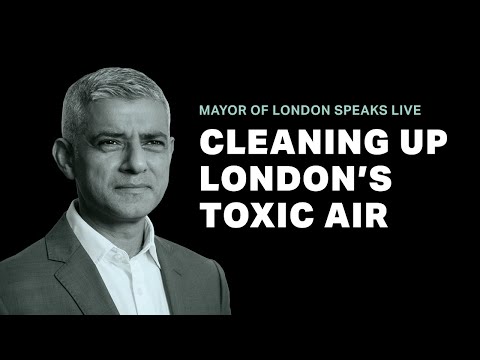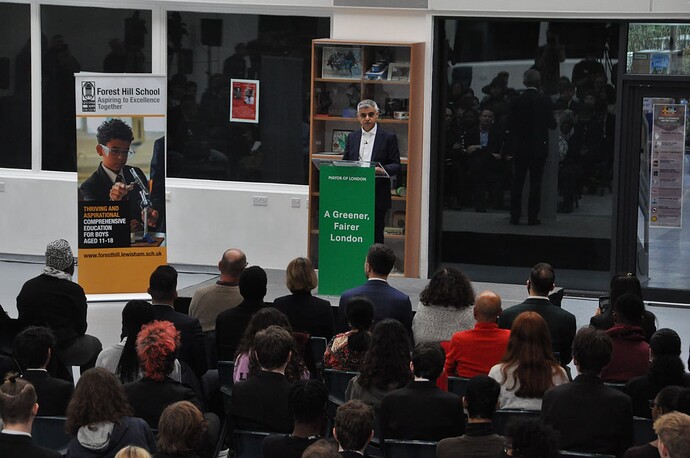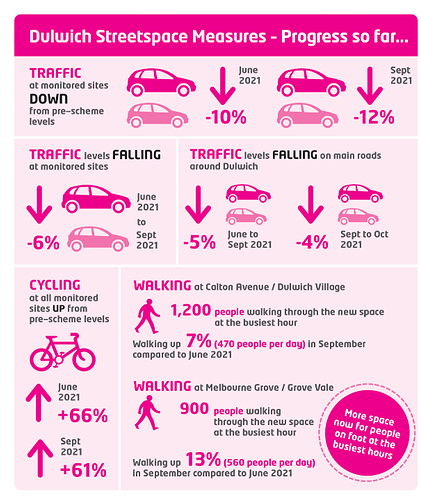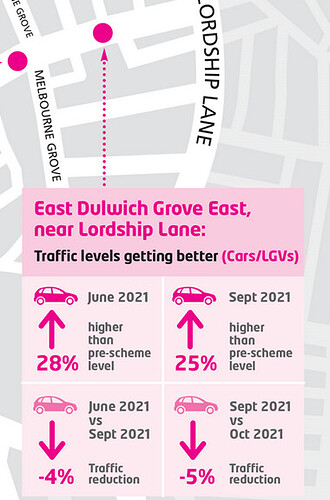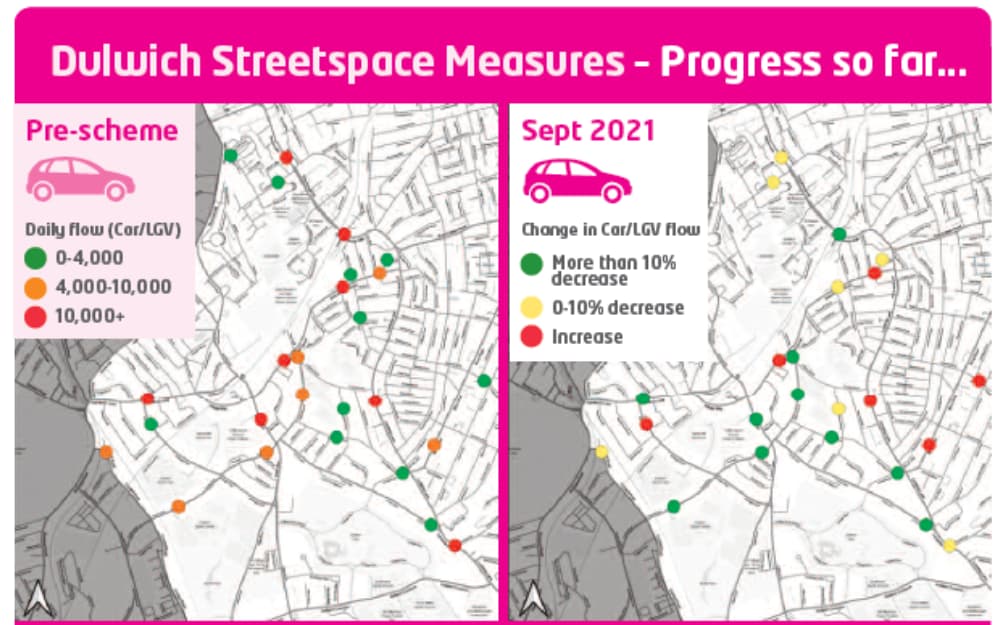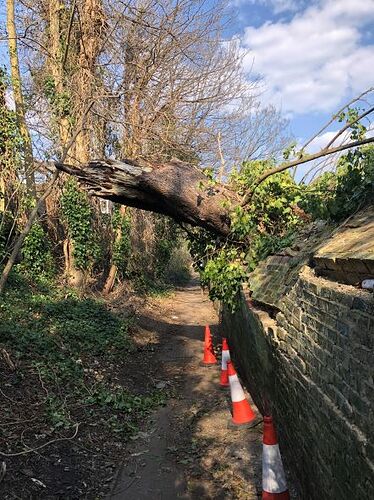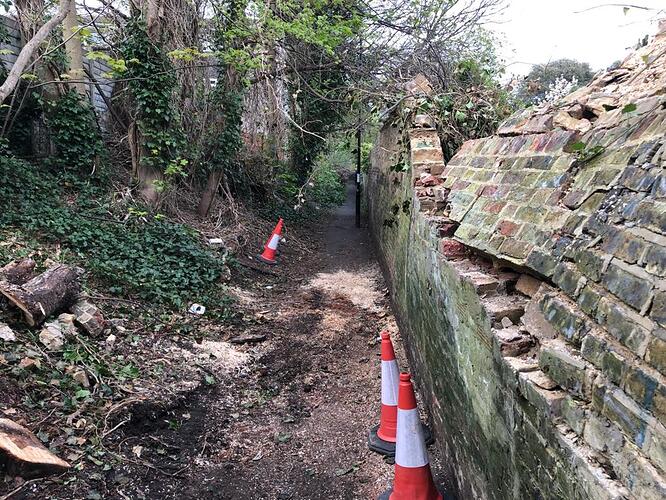Sadiq Khan announces ULEZ expansion at Forest Hill School


Sadiq Khan takes to the podium at 4:40.
The announcement he makes is that the ULEZ will expand to cover all Greater London by the end of next year. It’s also being covered in the press (though not referencing Forest Hill School):

That’s good news, but timescales seem quite short given how much warning drivers had for the south circular ULEZ.

Good news. And brave.

I’m in favour, but it would have been better if this had been set-out at the same time as the South Circular i.e 2 years after the zone will extend to x.
People may have purchased cars on the basis of being able to use them, tradespeople etc may need to change their vans or up their prices, which is all fine if it doesn’t affect you, but is a big financial hit potentially for people at a time when budgets are being squeezed.
The biggest thing I would like is much better secure cycle parking and much tougher penalties for bike theft so theft becomes rarer in addition to more dedicated cycle routes to make it safer for kids and those less confident on bikes.

The current Euro 4 standard required by the ULEZ for petrol engines dates back to cars registered after January 2006. I think there should also be a published plan to increase petrol engine requirements to Euro 5 (2011) and 6 (2015), with similar updates for diesel. This would also help buying decision for those that rely on cars and vans.

I thought it was a shame that Forest Hill School didn’t have a branded background behind the Lecturn to give the school some publicity and celebrate their achievements. They missed a trick.
As for the ULEZ, I think all of us on the borders saw an inevitable increase in pollution that would reduce over time. It is good that Sadiq has recognised this and we will get that reduction in 2 years rather than it being longer.
Exhaust emissions are only part of the problem and it is unlikely to reduce non-exhaust emissions, traffic and congestion which are not good for our health. Recent studies are now showing that non-exhaust permissions can be more harmful than exhaust permissions so why are we subsidising heavy electric vehicles.
It is perhaps time that they set out how this would become a journey pricing zone so that people get charged for the distance they cover rather than the nonsense that if you travel 1 mile you get charged the same as somebody travelling 100 miles while only producing 1% of the damage.

Is this true? That’s a genuine question, I’ve not seen any evidence either way.
My assumption was that over time from the announcement was made, many people would have changed vehicles and exhaust pollution would be lower now vs when the announcement was made.
On the border may have changed post the day of change, but I would have thought it would still be lower than pre-announcement. I accept however this is all assumption on my behalf, so was just wondering if there was any evidence either way?

With the exception of disabilities people shouldn’t really be driving distances of one mile surely? A relatively fit person can easily walk that in 15 -20 mins.

Not encouraging people to travel one mile by car just highlighting the current costing method.

It could be argued tht it is the short journeys that can easily be done on foot or by bus that need to be penalised the most.


Wonder what time he went? As the school entrances now have increased traffic going past them since they blocked off 2 roads that lead to Sydenham in the lockdowns. Which now causes more traffic & pollution around the school and its entrances.
Especially with all the HGV/building works going on in Mayow Rd too.
Obviously someone wasn’t thinking about our children & teachers, breathing in the not so fresh air in school & during keep windows open covid times too, or hot weather.

Fun fact - cars cause traffic and pollution, not road closures. The good news is that the alternative is to walk or cycle to school down the roads that are closed to through traffic and have much less pollution.
It seems like it’s people who do have alternative options to driving and choose not to are the ones not ‘thinking about our children & teachers’ - at least now they’ll have to choose a less polluting vehicle.
It will be interesting to see at what price point people choose to switch to more active travel.

I think that’s a bit unfair really. @Clair only said the school entrances see increased traffic since other roads to Sydenham have been blocked off, and like most schools I’m sure Forest Hill School already actively encourages use of public transport, walking and cycling among pupils (and teachers). It’s a secondary school afterall, so there’s not going to be many parents that routinely drop-off their kids by car.
Unfortunately the fact is, and I think what @Clair is getting at, is that unless you take the ‘long route’ down Perry Rise (past Brent Knoll School) and back up Sydenham Road, the only way to traverse between Forest Hill and Sydenham now is via Mayow Road or Dacres Road, passing Forest Hill School. The other route is via the South Circular and Dartmouth Road, which is very slow too.
Perhaps Mayow Road should be made a school street as many of the the other schools in the area got one. But that will force all traffic via Perry Rise and Bell Green, already a pollution hotspot on Haseltine Primary’s doorstep - as recognised in Mayor Sadiq Khan’s own report from 2018.
I don’t feel there are any easy solutions, but LTNs definitely produce winners and losers at least in the short term. Things like removing the most polluting vehicles from roads, either directly through things such as ULEZ expansion, or through encouraging changes in people’s habits are definitely a good thing though.

The main point though is surely the only thing that is going to reduce traffic and air pollution substantially is for everyone to take responsibility and reduce their personal car usage.
No special pleading about hobbies, being short of time, poor public transport etc…
We all have the solution to this in our control so we should take responsibility and stop thinking it is someone else’s problem.
You are not stuck in traffic, you are traffic.

Wouldn’t making everywhere within a one mile radius of a train station pay & display or permits only solve all of this?
Driving is made so easy in Lewisham.

Everyone knows driving a car causes pollution and that they should take responsibility and most of us do and actively travel round the area.
Is it beneficial that the many FHS kids who walk across from this side of the tracks get to cross a road that has been closed, breathing in cleaner air for probably about a minute each day but they get to school and breathe in more polluted air for 7 hours due to displaced traffic?
Traffic measures that apply to everywhere or everyone are generally good, there is a sense of we are all in this together rather than winners or losers, the chosen versus the unchosen.
ULEZ will now be good for all of Forest Hill.
I would agree, permit parking within one mile of the station would be good for the majority of locals including FHS and would remove pollution rather than just displace it.

I was a pupil at FHS in the late 50’s, early 60’s and any boy being taken to school by their Mum back then would have got a serious ribbing. Perhaps that kind of peer pressure should be encouraged today.

I think it is the same today, the same peer pressure means very few kids at secondary school today want Mum and Dad driving them there.

I’m unclear what this means - where will the zone boundary be now? Sorry if I’m being stupid!

From the linked Guardian article above:
So I guess the details are to be worked out - though they have almost 2 years in which to do it…

I would have thought at the very least it would be everything inside the M25 to give it a clear boundary. Huge assumption.

Oh thanks. It almost sounded from the thread title as though a random extension to the zone had suddenly happened but I think that’s just the way I was reading it!

It will be expanded to the London LEZ which is approximately the M25 but not always.

I actually thought the same at first too.

I agree but TfL would need political support from many areas outside London. I wouldn’t underestimate the challenge of getting all the stars aligned on this.
This was a sticking point in the past when handing over some Southern services to TfL was proposed. The Transport Secretary at the time, MP for Epsom and Ewell, was concerned about his affected Surrey constituents not being able to elect the Mayor which was at least one of the reasons why it didn’t happen.
Out of interest, how are ULEZ charges enforced within the boundary? As far as I’m aware, there is a tight cordon of cameras at the boundary itself but not many within the zone. Presumably this would also have to be thought about as the area is much larger and I would expect more cars being registered in Outer London, e.g. to pick up any journeys like Crystal Palace to Bell Green?

I think this is an excellent question, and i suspect the answer is that cameras are not present on many of the boundary roads, let alone random points within the zone. However, TfL is relying on general compliance of Londoners and the risk of getting caught (and getting a large fine) if you happen to pass one of their monitoring cameras.
But i think they have been more complete with the road signage than with cameras. For example Havelock Walk has a sign saying it is part of the ULEZ but i doubt there is a camera to ensure compliance - it wouldn’t be sensible, especially if the boundary is to move next year - making any cameras and road signs obsolete.
But i suspect there are some people getting away with driving non-compliant vehicles in the ULEZ and getting away with it, just like not every car that speeds or jumps traffic lights or parks illegally is caught or fined.
The move to the GLA boundary, rather than the M25, is because that where the GLA authority stops. They couldn’t make the boundary the M25 as it is just outside the GLA area. But there is already the old LEZ for lorries at the GLA boundary, so most of the infrastructure for expansion is already there. The only question is why was the initial phase of the ULEZ set at the south circular rather than the GLA boundary - it can’t just have been about ensuring Khan’s vote didn’t collapse in Outer London in the last mayoral elections - or can it?

Perhaps he is just being political/expedient or someone has reminded him of what he has said in the past and that he has a responsibility to all Londoners not just those in inner London.
"But pollution isn’t just a central London problem. Everyone should have the right to breathe clean air.
It is an issue of social justice - with the poorest Londoners, and Londoners from ethnic minority backgrounds least likely to own a car but worst affected by toxic air.
I think the attitude and understanding of most people has changed with the imposition of pollution/traffic displacement policies that just move the problem on.
It will be interesting to see when he is prepared to come out and say that all vehicles should be charged as the current ULEZ is making a lot less money than expected and he needs to balance the budget for transport.

And that is what we’re seeing not just in FH/Sydenham, but in Dulwich where the controversial LTN schemes in Dulwich Village and East Dulwich have sent traffic along boundary roads where social housing is prevalent.
Personally I don’t think LTNs work as they’re socially divisive where poorer people are worst affected, but I don’t think the ULEZ will work either. The Congestion Charge initially worked in bringing down traffic during the day, but businesses and other vehicle owners would rather pay, so instead of having certain groups who’d rather see vehicles banned all together, we need to get people driving hybrids, electric cars while improving cycle routes and public transport with some form of timed access to side roads rather than blocking roads 24/7 which don’t work.

Apparently that’s an urban myth perpetuated by a vocal minority of anti-LTN groups.

Considering that report is The Guardian which supports socialist schemes, I’d take that with a pinch of salt.
The Dulwich LTN has seen high density of traffic on boundary roads with social housing increase, the same pattern is happening on Mayow Road which has social housing.
Pro LTN supporters base their reasoning on ideological than practical reasoning to resolve air quality issues which continue to affect the poorest people across London in Labour held councils.

If you have a couple of spare days pop over to the East Dulwich forum and read the LTN thread. It highlights perfectly the Lies, damned lies and statistics quote. It also has more than a whiff of snobbery and inverted snobbery about it.
I don’t think you need stats to appreciate that where ever you put a boundary it will inevitably displace whatever you are trying to prevent to that boundary and the areas outside of the boundary.

I can see both sides to this.
One of the main arguments for LTNs has got to be that they are a deterrent to car usage in the first place because of their (albeit small) impact on average journey times. Alas, I suspect this might not be such a good selling point to Joe Bloggs.
At a more personal level, as a parent I’m much more concerned about safety on residential roads as they usually have poorer sightlines and lighting as well, and the fact that there seems to be a strong correlation between rat-running and speeding. LTNs can provide a level of protection away from main roads, as long as they include a ban of scooters.
Ultimately, it all comes down to the fact that London, and South London in particular, hasn’t got a capable trunk road system that is separated from where people live, move around and work in a way that other major cities have. Driving anywhere outside London that isn’t towards the M2/M20, you will, despite setting off close to a red route, undoubtedly be sent along back streets, bouncing over hundreds of speed bumps along the way. I can’t think of any other place where this is the case. This, alongside the existence of motor vehicle traffic in its own right, has created the issue of heavy traffic in residential areas in the first place. But we are where we are.
I’m yet to be convinced by the effectiveness of LTNs in the round. However, there probably aren’t that many options to do something with the seemingly never-ending budgetary stranglehold. Some form of smart road pricing has got to be the answer eventually.
In terms of those affected, I think we can probably all agree on the fact that LTNs produce winners and losers, even without considering road users.

Agreed, the South Circular is an ad hoc patchwork. The South and North Circular roads need to be replaced by a circular road system in tunnels. Unfortunately there is no political advocacy for this.

Or money to pay for it.

As seen today with the temporary traffic lights on the London Road/Devonshire Road/Dartmouth Road T-junction, it doesn’t take much for the traffic to easily build up and combined with the Dulwich LTN, traffic and the stench of petrol goes from London Road, past Hornimans onto Lordship Lane past The Grove up to Dulwich Library with no alternative routes also affecting local bus routes. I’ve seen 356’s going to Lower Sydenham only and the P4 to Ladywell.

Money can always be found when there is the political will to raise it.

I think people believe what they see locally rather than what they read in The Guardian.
We have an LTN/School Street that divides a local road into winners and losers with the affluent school with 1 in 10 recieving free school meals included and the not so affluent school with 1 in 3 recieving school meals excluded.
I am not anti-LTN. If the scheme is good, let local people decide and value their judgement. It has worked in a lot of other London boroughs where LTNs have been retained or scrapped leading to community support whereas Lewisham are likely to face a judicial review on the permanent retention of the Lee Green LTN after they ignored the views of the majority.
In the interests of fairness, I think we should swap round the divisive local LTNs every 2 years.
On Thorpewood, move the school street from the top to the bottom benefitting the less affluent school, reverse the LTN/road closure so it stops downward traffic
On Silverdale, change the LTN to Mayow Road benefitting FHS

It’s very problematic.
In SE23 - Devonshire Road, Ewelme Toad, Woodcombe Crescent, Tyson Road and several others have suffered big increases in traffic because of decisions elsewhere e.g. Manor Mount, Wood Vale, and the latest one Dulwich Village - which is increasing traffic in Lordship Lane, Forest Hill Road and other routes in Forest Hill and most especially in East Dulwich.

One seemingly insurmountable problem we have with traffic flow throughout SE London of course is the surface railway system that creates pinch points where the few roads that cross it, generally by the stations miles apart, are joined by others eg Dartmouth and Devonshire joining the South Circular; this is what creates localized pollution, rat-running etc and how you cure that to the satisfaction of all local people is way beyond me.

The local elections in both Lewisham and Southwark will be the deciding factor in whether these schemes continue. I fear if Labour get back in in Southwark, they’ll extend the LTN to cover streets on the eastern side of Lordship Lane bordering Forest Hill. Already Underhill Road is a nightmare in the peaks, along with the London Road end of Wood Vale as cars are using them as alternative routes to avoid the traffic on Lordship Lane/London Road.
There’s a pattern here of both Labour councils consulting, but not really listening to residents concerns, instead pandering to pro-cycling and environmental groups to which they have an ideological mutual understanding who seem to ignore the fact that the main roads in south London don’t have the capacity to cope with the extra traffic which used to use those lesser used roads as arteries to keep the roads flowing.

They’re pandering to the pro cycling active travel prime minister and government policy promoting LTNs
Read the foreword by the PM ![]()

This post was flagged and is temporarily hidden.

This post was flagged and is temporarily hidden.

I think it’s important to recognise that just because a scheme is well intended, and has noble aims which most people agree with, doesn’t mean that:
a) it can’t be legitimately critisised without those raising concerns being derided
b) the scheme itself is or is not a failure. It can be poorly implemented and / or planned and with the speed these were introduced these are more likely.
I’m personally in favour of school streets - the one outside Stillness Infant / Junior School is a great example which I expect has stopped some people driving but also has made the road outside the school much safer for children. This is course doens’t mean all school streets will work.
In terms of LTNS, it is hard to find their true objective and any real statistics against them. I do have a concern that quite a few local schools are on main roads eg Dalmain. If more cars are pushed onto main roads where a significant proportion of children spend most of their day Mon-Fri then this surely cannot be a good thing. Perhaps a dual approach is needed as main roads fall outside the LTN, but these things should be taking into account when reviewing the overall picture.

What does this mean? Not everyone’s choice of news but certainly no less trustworthy than any other mainstream newspaper.
An anecdote: I spent some time at a high school in the US. I remember a history class which was covering forms of government. One lesson had UK as a classic example of socialism on the blackboard. This was quite a shock to me coming from Thatcher’s Britain but the definitive signs were all there listed.
My point is, whether this was meant pejoratively or not, actions which have social good intention do not make them socialist per se and how one defines that anyway really depends on where you stand. So, not helpful to the discussion IMHO.

True but most impact is historic IMO. LTNs are not new, they are decades old. Only the name is new. People have got so used to the ones already extant that they are not bothered by them anymore, in fact the residents quietly enjoy them.
In the case of Devonshire and environs, there are extensive LTNs directly over the tracks, Grierson and Garthorne etc. This has been covered on this site before and I wish that the same principle could be extended.

That’s a fair point, and a good example around Garthorne etc (though there are periodic reports of people speeding / racing down those roads as they have less traffic). I guess it’s slightly easier there as borded on on side by the railway so a natural barrier so in a recatangle on side has a natural LTN, you make one other side blocked and there is no point going through. I suspect this is harder to do in other places.


It’s as biased as the right-wing press. The Guardian is an echo-chamber newspaper that follows the mantra of socialism is right and everyone else is wrong. See the Morning Star which really does wear it on it’s sleeve.
The fact remains that The Guardian will publish what it feels is ideologically right and in this instance of their LTN piece, on the ground they don’t reflect what is published in that article.
If you want a newspaper that doesn’t pander to the Tories or Labour, the ‘i’ Newspaper is the only one that isn’t biased, despite being owned by the Daily Mail.
With regards to this topic, supporters of these schemes have been either champagne socialists who can afford to support socialist policies without affecting them financially or hardcore environmentalists who want to take us back to the stone age and see cars, even those who have EV cars as evil and I say this as someone who uses public transport or walk as my main way of travel.
I’m not a Tory by any means, but from what I’ve dealt with on this topic, I’ve had to learn a lot about how ideological LTNs are and the people who support these schemes regardless of the practicality in the real world.

Lewisham is very pro-car in comparison to other inner London borough’s, even if the powers that be claim to be supportive of alternative modes of transport.
- no proper cycle lanes in the borough
- where there are marked out areas on the road for cyclists, cars are not stopped from parking on them, rendering them a waste of paint
- speeding is not dealt with. I frequently see buses speeding around around that blind bend in Dartmouth road and having races on residential roads
- no action to make the most important junction in FH safer for pedestrians
- general lack of pedestrian crossings, blaming TFL or DoT or whoever
- cycle hangars take years to apply for, and to be installed
- no pay and display / permit only rules within a certain radius of train stations
- poor enforcement of cars parking all over pavements (and people’s property if they wish)
- lack of management of TFL and Southern, who get away with providing a crxp service, meaning people think it is not worth the hassle, and use their car.
- does anyone actually issues parking tickets for people parking where they should not? It seems to be a free for all for car drivers.
- the council DOES NOT seem to grit roads and pavements in Winter, making it dangerous to leave on foot/bike.

There may not be any cycling lanes in this part of the borough but there are in others e.g. on Lewisham High St going towards Catford between the junction with Morley Rd and the junction with Ladywell Rd and on Molesworth St in Lewisham in the direction of the station!


I agree with your final statement even though I am a Guardian reading cyclist.
The Guardian, socialists, the pro-cycling lobby and even our great prime minister are not always right and it is right to ask questions and above all we should ensure schemes work.
Many would say that Lewisham is very pro-car but I think the real problem is they can’t do the basics and lack ambition.
As they seem to fail by doing too many things, they should just try and do one thing well which I think most people would agree is the FH station crossing. It is the one thing we all share whether we walk, cycle or drive locally.

The winners enjoy them, I don’t think everyone has got used to them.
Sadly, have to agree.

This may be true, but there’s actually less traffic than there was before.
https://www.southwark.gov.uk/transport-and-roads/improving-our-streets/live-projects/dulwich-review
Have a look at the actual traffic monitoring from Southwark.
And let’s not forget that ‘high traffic density’ you mention comes from increased car use in the last decade. What you think is not normal is simply due to more and more cars.
The original link I posted was from a piece of academic research and was reported on in the Guardian - it’s not a ‘socialist’ viewpoint, it’s purely researched facts not opinion.
I’m also in favour of widening the ULEZ, whether it reduces traffic or reduces pollution from existing traffic, either is a small win and move in the right direction. Especially those of us who need to breathe to get around. And yes I have a car, yes I pay ULEZ charges, I just rarely use it.

Also note one of the other images from the research showing traffic increase in some locations:
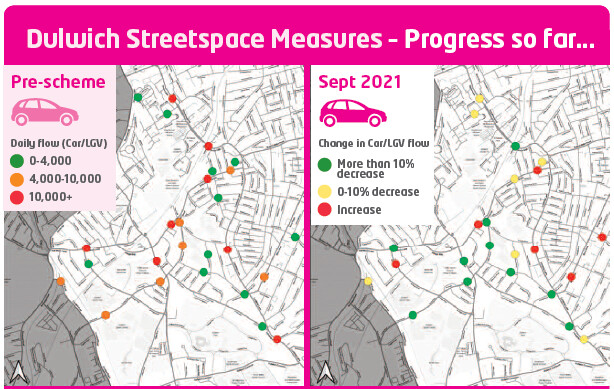
I think this is the crux of the problems with many of these LTN’s; there are winners and losers.
At least the ULEZ expansion will cover everything equally and remove pollution directly, rather than risk pushing it around, or even increasing it.

.Reduce some sources of pollution but NOT remove any.

The validity of these figures are being discussed continually on the East Dulwich Forum. It would appear that even local Councillors in favour of the LTN’s have stopped quoting them as the data collection methods have been, shall we say ‘questionable’
As an example some of the data was collected during the fuel crisis in September 2021.

I wouldn’t trust those inforgraphs - not that I have any particularly views on the Dulwich LTN. But the monitoring points did not include Lordship Lane section where there are shops or the South Circular.
And there are monitored places where traffic has gone up by over 25% compared to pre-scheme levels.
Most of the largest increases in traffic levels have been on the most congested roads:
Anybody living on these roads is likely to experience increased levels of traffic and pollution. I doubt there are any LTNs that do not shift pollution but that is generally a secondary consideration to the safety of pedestrians and noise from cars rat-running in more (and narrower) residential streets.

I think very few of the people who were consulted trusted the Infographics. The consultation was approximately 2 out of 3 against the LTN asking for it be returned to the original state.
The consultation report at 64 pages makes interesting reading. https://moderngov.southwark.gov.uk/documents/s101517/Appendix%20D%20-%20Dulwich%20Review%20Consultation%20Report.pdf
The summary of the results tries to accentuate the positives but can’t hide the fact that it all comes down to winners and losers. Perhaps Southwark and Lewisham could learn from the ULEZ about what benefits us all is generally supported by all of us.
Summary of results
the majority of respondents opted for the response in each case that preferred to ‘return it to the original state’. This is true both for residents of the consultation zone and outside, however it masks considerable differences between views on individual streets – in most cases, residents of those streets with traffic filters were in favour of them being retained.Key themes from all responses, also reflected in meetings and emails received:-
Concern about displacement of traffic and pollution onto other roads – in particular Croxted Road and East Dulwich Grove
Inconvenience and time added to all car journeys, both for people within and travelling through the area
Difficulties for older people and people with disabilities in accessing appointments and maintaining their regular activities in particular, though residents with blue badges within the scheme area can have exemptions to the timed closure, this was regarded as unfair to other disabled residents
Difficulties for parents with the school run, particularly those with children at different schools and/or needing to get to work
Relative lack of effective public transport options, and effects of traffic on some bus routes
Concern at loss of access for emergency services
Unfairness and unpredictability of fines issued at camera-controlled closures – signs felt to be unclear
Timing of camera-controlled closures leading to traffic build-up and affecting local businesses – many people felt that these should operate for a shorter/different time and/or only during school term
Difficulties for friends, family, health care visitors and tradespeople in accessing the area
Increases in congestion, standing traffic and pollution on some streets, including some with schools
Concern at safety risk for pedestrians where sharing the road space with cyclists

Thanks for posting this.
As you say, lets hope this is used as a learning opportunity for all concerned.

We received 7,542 responses to the survey. Of these 209 were voided as being duplicates (people providing more than one response). Of the remaining 7,333, some 5,538 identified themselves as living or working on streets within the consultation zone.
We operated a ‘unique identifier’ system with numbers available either on the envelopes that the newsletter came in or in the emails that were sent – however only 1491 responses included anything in the ‘unique identifier’ field, and many of these were incorrectly used – therefore this metric has not been used in the analysis below.
Interesting.
Almost 2000 people who don’t live or work within the consultation zone let alone within one of the schemes commented. That’s more than 25%. And only 20% of people managed to confirm their Unique ID. It seems to suggest a lot of people from outside could have been encouraged to submit responses i.e a nice internet pile on.
Interesting takeaway though is that people who live within a scheme approve of it, and people outside the schemes don’t want their roads closed, so it seems like everyone should be happy ![]()
I suppose until things return to near normal we won’t know if people return to public transport let alone demand destruction from higher fuel prices. It’s quite hard to benchmark to be fair.
Also worth noting behavioural changes take time.
Seems like the short term winners have been the lawyers who recently recommended against any further legal challenge in the High Court but presumably got paid for that opinion!

I wish I could trust this, but it is data from unspecified “monitored sites”, and the hours of monitoring and direction of traffic are also missing.
The person who devizes the formula to solve this issue, can win an election anywhere in England.
Seems obvious to me, that if your road is closed to thru traffic you’re a winner and likely to approve.

It is indeed obvious. What’s more interesting is that people who don’t live in LTNs seem to not want their roads open only for local resident access. Therefore they should also be happy in theory - so why aren’t they winners too? Why is it only those inside the LTN who are described as winners?
Conversely do you think they’d change their mind and consider themselves winners if they could be inside an LTN, once they experience the benefits?

I was thinking the other day there is not one single thing on the roads off Devonshire (Ewelme, Tyson etc.) that discourages traffic / promotes walking or cycling, so I think this sums up this area perfectly.

The cars parked on both sides of the road discourage me from driving along these roads. If you want to encourage walking/cycling, I’m not convinced some of the steepest hills in the area are the best place to start.

Shame the parked cars don’t do enough to discourage the 4800 others that rat-run down through streets every day.

I think sometimes people mostly walk because they find a better route, they don’t need to be encouraged or discouraged.
One example of this is the footpath that leads between Thorpewood/Derby Hill Crescent and London road opposite Sainsburys, used by locals to go to the High Street and kids to go to Eliot Bank. It seems a shame that it has now had an overhanging tree for about four weeks. Would the same be tolerated on a local road?
This lack of attention and maintenance on routes not used by cars discourages walking.

I rather suspect that this delay is due to the insurers of the council and the affected property arguing over who should pay a) to remove it and b) to repair that very expensive looking wall; plus the difficulty of getting equipment close enough to lift even pieces of it.
Meantime it shouldn’t discourage people from using the footpath as it rests above head height.
